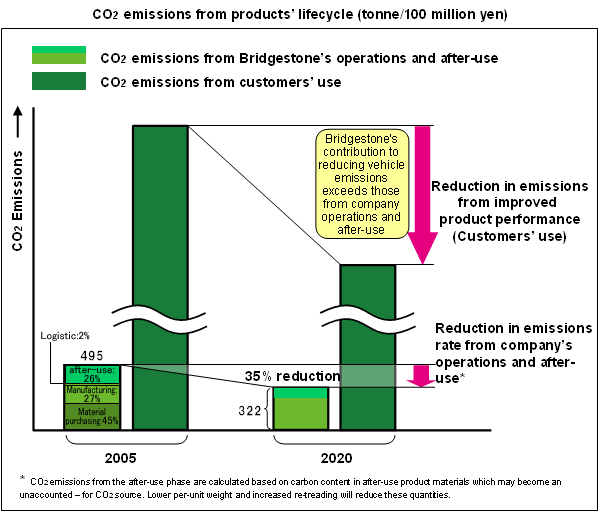Bridgestone's CO2 Reduction Goals Reflect Dedication to the Environment-A major step in the continuing journey toward building a more sustainable society-
Tokyo (April 30, 2010) —Bridgestone Corporation (Bridgestone), on behalf of its worldwide family of companies, today announced that it has established targets for the reduction of CO2 emissions throughout all it's products' lifecycle in order to help address climate change and support a sustainable society. By establishing these targets, the Bridgestone Group is further increasing its focus on, and commitment to, the environment and is setting the stage for additional environmental initiatives.
As part of Bridgestone's Global Environmental Mission to help ensure a healthy environment for current and future generations, the global company recognizes the importance of building a sustainable society. Bridgestone is taking decisive action with respect to three important environmental perspectives: reducing carbon emissions, resource conservation and ecological conservation. These new carbon reduction goals are Bridgestone's direct response to the challenging demand for development of a low carbon society to address climate change and other important energy related issues.
Bridgestone has established a global goal of 35% reduction in CO2 per sales from the company's total operations (raw material and component procurement, manufacturing and logistics) and also its products' “after-use”. Further, Bridgestone is pursuing a challenging goal to improve tire rolling efficiency by 25%, resulting in less fuel use and CO2 emissions from driving, while also extending the life of its tires. Bridgestone estimates that the potential reduction in CO2 emissions from helping improve their customers' fuel efficiency exceeds the emissions related to Bridgestone's operations and its products' after-use. Both of these goals are planned to be achieved by 2020 (compared to a 2005 baseline).

*Click the following link for the calculation method.
https://www.bridgestone.com/corporate/news/2010043001_attachment.pdf
In order to achieve these aggressive goals, Bridgestone intends to enhance the company's environmental initiatives across its products' lifecycle.
1. Raw material and component procurement:
While continuing its clear focus on enhancing product safety, quality and performance, Bridgestone will increase its focus on procuring more environment-friendly materials and developing advanced materials that help reduce resources used in its products.
2. Manufacturing:
Bridgestone will improve manufacturing efficiency through equipment and process enhancements to further reduce the energy invested in each product, while further developing products to help minimize footprints on the environment, along with enhanced product safety and quality.
3. Logistics:
Bridgestone will strive to increase transport efficiency through improved distribution strategy, including routing and delivery fleet performance.
4. After-use:
Bridgestone will focus on prolonging the life of its tires and expanding retreading (reuse) of truck, bus, aircraft and off-road tires, as well as reducing per-tire weight, to help reduce waste generation rates. Bridgestone continues to pursue the 3R's (Reduce, Reuse and Recycle) to enhance resource savings at all stages of its operations.
5. Product development:
Regarding a tire's lifecycle, Bridgestone estimates that about 90% of CO2 emissions related to a tire are generated by its use on a vehicle. To help drivers reduce emissions, the company will further enhance its development of tires with improved rolling efficiency to reduce fuel use, while also expanding educational programs on tire and vehicle maintenance and eco-driving.
Bridgestone will also continue developing other products to help save energy and reduce CO2 emissions, such as electronic paper, designed to replace thousands of printed pages, and building products which insulate buildings and reflect energy in order to maintain temperatures.
Bridgestone's environmental focus and these new CO2 emissions reduction targets will advance technologies across the lifecycle of its products to significantly reduce their environmental footprints while also helping customers reduce theirs. These efforts are designed to help address climate change and build a more sustainable society.
Bridgestone Corporation, headquartered in Tokyo, is the world's largest tire and rubber company. In addition to tires for use in a wide variety of applications, it manufactures a broad range of diversified products, which include industrial rubber and chemical products and sporting goods. Its products are sold in over150 nations and territories around the world.


